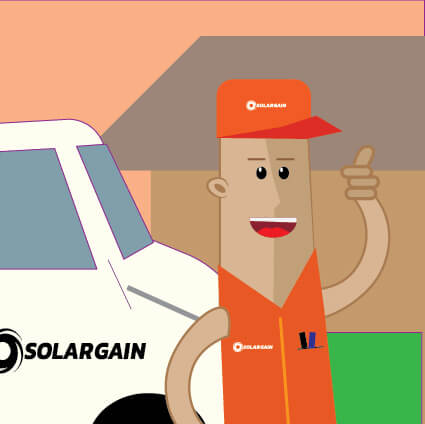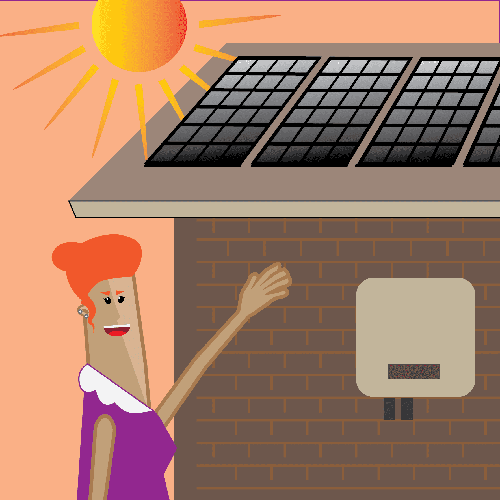
Here's a good place to start
Do you like the idea of solar power, but aren’t totally convinced it’s for you? Solar power has changed the lives of thousands of Australians, helping them save money, cut down on pollution and add value to their homes. In fact, over 3.5 million Aussie homes in both regional and major cities including Perth, Brisbane, Melbourne, Adelaide, Sydney and our capital city, Canberra now have rooftop solar power. So, how can you get started with solar power for your home or business?
Get started with an obligation free consultation
The best way to get started is by speaking with one of our renewable energy consultants. They’ll help you understand how solar power works and assist you in finding the solar power system best suited for your needs. Simply call us on 1300 73 93 55 for obligation-free advice and a quote on setting up solar power for your needs.
4 EASY STEPS TO GETTING YOUR SOLAR PANELS INSTALLED

Get in touch
Our solar team is ready an waiting with a host of technology tools and expertise to give you the best solar yield and returns.

We take care of everything
Our solar team is ready an waiting with a host of technology tools and expertise to give you the best solar yield, battery capacity and energy savings.

Get Installed
Our fully accredited and licensed electricians take great care with your solar panels installation to ensure your system is correctly installed and compliant with Government standards.

Enjoy your free power
Sit back and relax as your system will now be fully functional. Your solar energy system is in good hands with our dedicated after sales support.
Grid-connected solar PV systems
Despite what some might think, solar power is actually very simple.
- Solar modules (panels) on your roof convert sunlight into DC electricity.
- A solar inverterconverts the DC electricity into 240V AC electricity, the type of electricity suitable for home use.
- Appliances in your home will utilise the AC from the solar power system first and draw electricity from the grid to make up the remainder of your energy consumption.
- If you produce excess power, it’ll be fed back into the electrical grid (an interconnected network which delivers electricity from producers to consumers). Prior to installing solar, this is where your electricity would have come from.
- In addition to capitalising on the sun’s energy to power their home, some customers may also be eligible to receive credit from their energy retailer, as a way of saying ‘thanks’ for feeding excess solar energy back into the grid.
Solar Battery Systems
Solar batteries are energy storage systemsthat enable you to use the electricity generated during the day to power your house at night. They can be connected to your solar inverter via AC or DC. Among other advantages, choosing DC is more efficient as there is no requirement to convert the energy to AC power.
Blackout Protection - powering your home in a grid outage
Blackout protection is becoming increasingly popular. This requires the addition of a backup gateway or 'backup box' hardware that is installed near to your battery. Together, they enable you to to keep the lights on and the fridge running, even during a power outage.
Solar Hot Water Systems
Solar energy systems can do more than just power your home. Combining a solar hot water system with your solar PV system will bring your home even more energy independence. If you chose a heat pump like iStore's 270l hot water heat pump, you can save up to 70% on your water heating costs and reserve the space on your roof for solar panels to maximise the size of your solar PV system.
How solar saves you money
With a solar PV system, you’re producing your own power, meaning you’re buying less from your energy retailer. For example, let’s say you have 10 kW of draw from your home appliances, and your solar PV system is producing 9 kW. You’re only buying 1 kWh from your energy retailer, saving you up to 65c/kWh. On top of that, if you’re producing more than you’re using, your excess energy could be funneled back into the grid for even more savings. Remember that kWh is “units” on many power bills. Additionally the Federal Australian Government and many state governments offers generous rebates on solar, battery and energy-efficient hot water systems, allowing you to benefit from even more savings.
Choosing the right solar system
Firstly, you need to check your power bill, where you’ll find your average daily consumption in kWh. Then you need to consider when you use your power - at minimum, you want to cover your daytime energy consumption. Each kilowatt (kW) of solar power will produce, on average, approx. 4.6 kWh per day, but this varies depending on a number of environmental conditions. Your system will also need to output enough power during winter when energy generation may be less than the maximum.
So, if your average daytime consumption is 20 kWh, you’ll need at least a 6.6 kW system. If you consume 30 kWh a day, then a 8.6 kW solar PV system would best suit your needs. If you are planning to install a battery you will also need enough solar to charge your battery in the day in addition to covering your daytime consumption.
The type of system you can install is also determined by whether your home is single or three phase. In Australia, most new homes are single phase which means they supply power to the home using a single phase. However some older homes or upgraded homes supply power across 3 phases.
An experienced consultant will help determine the best solar power package to suit your needs.
Speak to a solar expert
(All our call centres are in Australia and we pride ourselves on offering professional and helpful information. We promise warm and friendly advice so give us a call.)
Some frequently asked questions for newbies
Australia is a great place to take advantage of solar energy. Systems in our corner of the world will produce more than they would in most places throughout Europe. In Australia, a north facing roof between 20 and 30 degrees is the most ideal aspect. Lower or higher pitches can also be used, often to great effect. Panels facing east or west will still generate good yields, typically only 15-17% less than they would on the north. Eastern panels will generate power earlier in the day then north and western panels will produce power later in the day. Many people decide to put a portion of panels on the western aspect, as it improves the production later in the day when many appliances are commonly used. Using the power you're producing has financial advantages, which is why it can make sense despite the lower production.
Solar panels work on sunlight, not heat. Hotter days generally have more sunlight and hence better production, but the heat actually has a negative impact on solar panels. They are not intended to perform at their peak rated power output, as the test conditions they are subject to when they receive their rating will not be perfectly replicated in the real world (even in Australia). This is why suppliers give you an estimated energy yield in kWh (units) per day, as this is what you buy and sell from your energy retailer. In the middle of a perfect day in summer, you could expect to see your panels reach around 85% of their peak power output. Early in the morning, late in the day or in overcast conditions, this will be reduced. Your power output will bounce around a lot, so focus on your energy (kWh) yield when looking at the performance of your system.
Yes, however you need to ensure your current system is compatible
An AC coupled or DC coupled system can be retrofitted to almost any solar power system currently installed. However, an AC coupled system is not as efficient or cost effective, as it requires extra components in addition to the batteries. Batteries will require specific components to integrate them into your system, and there is often more than one approach that will work. We can determine the most suitable option for you and provide you with a system that has, or has the capability to add, your desired battery solution.
Yes, and it's usually quite significant. Solar panels facing north should ideally be in full sun from at least 9am till 3pm, as this is when they will produce the majority of their power. If they are east facing panels, then this changes to 7.30am to 1.30pm and for west facing panels, 11.30am to 5.30pm.
Shading from objects like flue vents, trees and other structures should be avoided where possible. Careful design with a consultant and your install team can help with this. We don't recomend using micro inverters or panel level optimisation in most cases as the poorer performance of a shaded panel will reduce the capability of the non shaded panels to the same level. Most larger inverters will have two maximum power point trackers (MPPTs), which means shaded panels on one tracker will not effect panels on the other. Also be mindful of future shading issues, as new structures may be built and trees often get bigger.
Other objects like power lines and antennas can cast a very thin and small shadow. While not ideal and to be avoided where possible, these will not have a drastic impact on your system. Panels should not be placed directly under antennas though, as birds are likely to perch on an antenna and leave excrement on the panels.
An inverter performs a variety of functions. Primarily, it converts the DC power from the solar panels into 240V AC power that the house uses. In addition to this, it has one or more maximum power point trackers (MPPTs) that regulate the voltage of the panels to achieve maximum power. Inverters with more MPPTs give you greater flexibility when designing your system. You can monitor the performance of your solar power system using an app on your smart phone or tablet.
Better inverters will perform their functions more efficiently, are more reliable, offer more comprehensive monitoring and features. High DC to AC efficiency is good, however it is not the only factor that impacts yield. The MPPT has complex algorithms that determine the highest yielding operating voltage. The better inverters have more refined algorithms from years of development, so they produce more power. Inverters from better manufacturers are less prone to failure, give better support, longer warranties and quicker replacements should something go wrong. They’re also far less likely to fail in fringe of grid or remote areas, where grid fluctuations are more common. Finally, better inverters will offer you connectivity and online monitoring for your system and even provide alerts to monitor the consumption in your home in real-time – something which is becoming very popular.
Your situation and roof has a big impact on which inverter you should choose. Solargain has a wide range of inverters from companies that have stood the test of time in the Austalian market. This wide range, combined with our experience, enables us to recommend the perfect inverter for your project.
This can be quite tricky, as they all look very similar and all solar providers will tell you that their panels are high quality. Doing research into your panel is important, as low quality panels often degrade quickly and are prone to manufacturing defects. Also, a 25-year warranty is only as strong as the company providing it, so you need to do some research into the manufacturer as well. Here's a few tips on choosing a panel most suitable for your project.
If solar is a long term investment (three years or more), we recommend choosing a tier one panel. Panels from tier one manufacturers make up the top two percent of the panel market. The companies providing these panels have automated production facilities (reduces defects), are vertically integrated (meaning they have control over the entire supply chain) and have been producing panels for five years or more. There are many brands out there that are considered tier one and choosing a panel from one of these is a great way to ensure you're making a good investment. In addition to this, we recommend choosing a tier one provider that has a strong presence in Australia, as any warranty claims will be much easier to manage if there's local support. Finally, consider how many panels the supplier has installed for the manufacturer - tier one or not. Providers that have installed many panels from their manufacturers will have had to deal with warranty claims themselves. If the manufacturer was consistently not honoring warranties or regularly providing poor products, they would have moved on to another manufacturer. Providers changing panel manufacturers regularly are either frequently getting poor quality products or a consistently shopping for the lowest priced panel in that quality category, rather than a good quality product.
Premium panels are available and should be considered if you demand the best or have no intentions of moving from the home you're installing them on. Premium panels will give you slightly more kWh per kW from day one, degrade less than other panels, perform better in lower light and in extreme heat. These features don't pay for themselves straight away, which is why we believe they're primarily suitable for investments five years or more. Premium panels can come with better warranties, be it longer, less degradation or inclusive of labour costs for panel replacement. They may also be more aesthetically pleasing with darker cells and black frames. Lots of panels claim to be premium, but you won't know for sure until many years down the track. This is why we recommend looking for panels that have good performance in reputable independent tests and have sustained that performance over many years, ensuring the low degradation which many claim.
For people considering a short or medium term (1-3 year) investment, it still makes sense to consider the panels you are receiving. If the panel manufacturer disappears or if you don't know who they are, it can be very difficult to follow up any warranty claims - which can be very likely early in product life. Tier two manufacturers can be a good choice and are obviously cheaper than panels from tier one manufacturers. Tier two manufacturers have been producing panels for at least two years and are still in the top 10-15 percent of the market. These are good choice if you're looking for a cost effective option.
It’s very common to put more panel capacity on an inverter than its maximum output. There are two main reasons for this, firstly the panels will never perform at their peak rated power (or nameplate) output. The panels get their rating from standard test conditions (STC) which will never be seen in the real world at the same time. Below are some of the conditions in the test compared to what happens in the field:
- The panels are flashed with 1000wm2 light intensity. Even in most places in Australia, we don't often get that amount. It can occur in the middle of a clear day though.
- The panels are in a temperature controlled environment of 25 degrees. The panels would be at about 50-80 degrees in the middle of a clear day.
- The panels are perfectly perpendicular to the rays. In most places in Australia, when panels are mounted on a pitched roof, the sun's rays will not be perpendicular in summer.
- The flash test is done on the panels with minimal cable lengths, resulting in next to no loss here. This is not possible when panels are installed in the field.
- The panels will degrade and accumulate dirt over time. In the flash test they're brand new and have been cleaned.
Due to the above, 6.6 kW of panels installed in most places around Australia would rarely output in excess of 5 kW. This is why selecting an inverter that has the same or higher output capacity of your panels is an added cost for no gain. Safety of the inverters is not an issue, as quality inverters are designed for this and are warranted for much higher input capacities. For example, Fronius warrant their inverters to double the DC input capacity than the AC output capacity. And iStore warrant up to 250% AC output capacity. This means you could put 10 kW panels on a 5 kW inverter system without jeopardising your warranty provided it was installed correctly.
The second reason is that while your inverter will never output more than its maximum AC power output, you will generate more yield (kWh) overall. If you did have a case where the panel capacity exceeded the nominal output capacity, it will for a short period of time be able to operate at the maximum output capacity. If this is exceeded, the inverter slows the output (referred to as "clipping") of the panels, converting only what it can. While this may seem like wasted power, it's seldom occurring and is far outweighed by the system turning on earlier, turning off later and producing more power in anything other than perfect conditions. It's a small sacrifice for a big gain.
For lower energy users we tend to recommend 5kW inverters as increasing your inverter capacity beyond this point excludes most residents from selling energy back to the grid. 6.6 kW in these systems is also by far the most cost-effective and you will rarely, if ever, see any clipping. Also consider that if panels on your roof face different directions, they will reach peak output at different times throughout the day, so it's even more common when this is the case.
Yes. The cost varies between states and energy providers. Households that already have a smart meter from your energy company will be charged a fee to configure the meter to accommodate for solar. If you do not already have a smart meter, your retailer will need to install one for you. Most energy providers have these costs absorbed into your billing so you don't pay a lump sum cost for your new meter.
The second smart meter you will require is part of your solar system. It's purpose is to monitor your solar power generation, consumption and storage.
- New South Wales: As soon as the system is installed and the meter changed and/or reprogrammed and connected to the grid.
- Queensland: As soon as the system is installed and the meter changed and/or reprogrammed and connected to the grid. The meter upgrade may take 2-4 weeks after installation.
- South Australia: As soon as the system is installed and the meter changed and/or reprogrammed and connected to the grid.
- Victoria: As soon as the system is installed, inspected and the meter changed and/or reprogrammed and connected to the grid.
- Western Australia: As soon as the system is installed and the meter changed and/or reprogrammed and connected to the grid.
The system will automatically shut down with a power outage and switch back on when power is restored. If your system does not switch on when the power is restored, please do not hesitate to contact the Solargain Service Department on 1300 73 93 55.
A typical 3 kW Solar Energy System will offset the following over a 25-year period:
- Greenhouse gas - 160 tonnes (360,000 lbs)
- Smog - 540 kg (1200 lbs)
- Acid rain - 440 kg (1000 lbs)
- Kilometers in the average car (lifetime) - 960,000 km
- Kilometers in the average car (per year) - 38,000 km
- Trees - The equivalent of planting roughly 3 acres of trees
- Coal saved over the lifetime - Over 80 tonnes of coal will not need to be burned
Solargain provides a five year comprehensive warranty on the entire solar power system. This covers both parts and labour for all the components in your system. There are no extra costs associated with maintaining this warranty and while we recommend keeping an eye on the system performance, no scheduled maintenance is required.
The manufacturers also provide a warranty with their products. The panels all have a performance warranty (commonly 25 years) and a product warranty (12 to 25 years). The product warranty covers any defects of the panel that don't impact the performance. After the product warranty, any defects must impact performance before you're eligible for repairs or replacement. Note that the panel warranty typically does not cover the labour costs involved in replacing the panels, although Solargain will do this in the first five years as apart of their comprehensive warranty. Some panel manufacturers (like Hanwha Q CELLS and SunPower) can have a labour component in their warranty, but speak to your consultant for more details. Inverters typically have a ten year product and labour warranty, however some will have longer warranties or offer them for an additional fee.
Solar batteries generally carry a ten year parts and labour warranty. While iStore Hot Water Heat Pumps have a 5 year parts and labour warranty with 1 year on valves and fittings.




